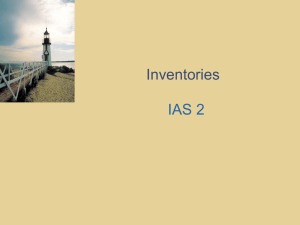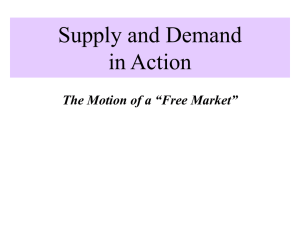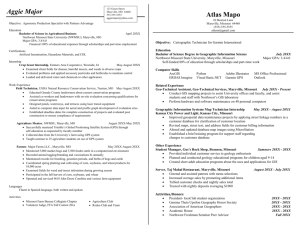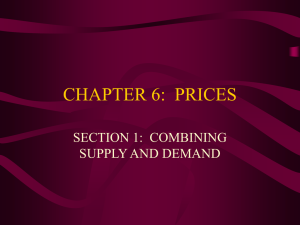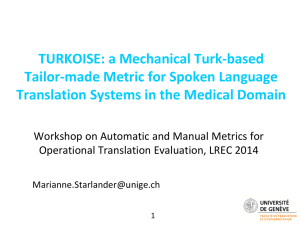Stock
advertisement
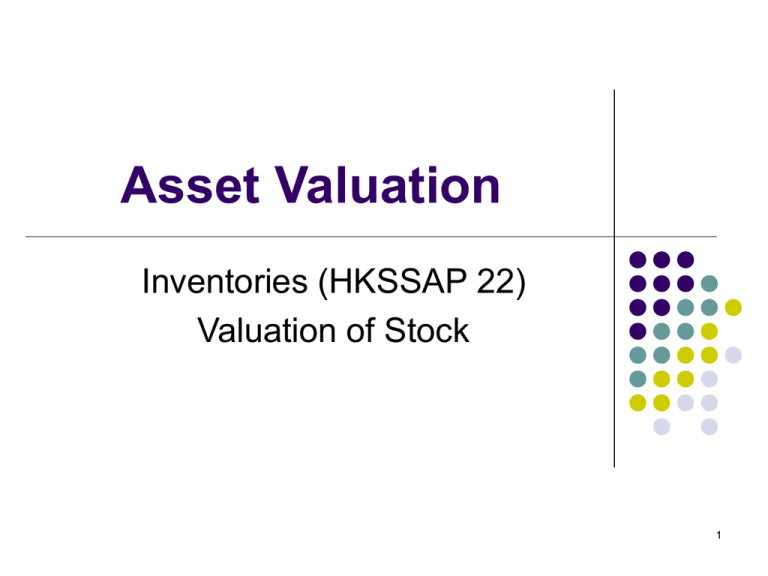
Asset Valuation Inventories (HKSSAP 22) Valuation of Stock 1 Introduction Hong Kong statement of Standard accounting Practice (2.122) – Inventories (i.e. Stock) is to prescribe the accounting treatment for inventories 2 Inventories Inventories are assets: Held for sale in the ordinary course of business In the process of production for such sale In the form of materials or supplies to be consumed in the production process or in the rendering of services 3 Classifications of Inventories Merchandise Production supplies Materials Work in progress Finished goods 4 Measurement of inventories HKSSAP 22 stated that inventories should be measured at the lower of cost and net realisable value 5 Cost of Inventories The cost of inventories should comprise: Cost of purchase Cost of conversion Other costs incurred in bringing the inventories to their present location and condition 6 Cost of Purchase The costs of purchase of inventories comprise: The purchase price Trade discount, rebates and other similar items are deducted in determining the costs or purchase Import duties Other taxes Transport, handling and other costs directly attributable to the acquisition of finished goods, materials and services 7 Cost of Conversion The costs of conversion of inventories include: Costs directly related to the units of production (e.g. direct labour) Fixed/variable production overheads (e.g. depreciation and maintenance of factory building and equipment, indirect material 8 Other Costs Other cost are included: Cost of inventories that they are incurred in bring the inventories to their present location and condition For instance, include non-production overheads or the costs of designing products for specific customers in the cost of inventories 9 Costs excluded from the cost of inventories Examples costs excluded from the cost of inventories and recognised as expenses in the period in which they are incurred are: Abnormal amounts of wasted materials, labour or other production cost Storage costs, unless those costs are necessary in the production process prior to a further production stage Administrative overheads that do not contribute to bringing inventories to their present location and condition Selling costs 10 Cost of Inventories of a Service Provider The cost of inventories of a service provider consists of the labour and other costs of personnel directly engaged in providing the service, including supervisory personnel, and attributable overheads Labour and other costs relating to sales and general administrative personnel are not included but are recognised as expenses in the period in which they are incurred 11 Net Realisable Value (NPV) Net realisable value is the estimating selling price in the ordinary course of business less the estimated (further) costs of completion and estimated costs necessary to make the sale (marketing, selling and distribution cost) 12 Example Articles 1 2 3 4 5 6 Stock at 31 Dec 20XX Categories Cost Hats $80 Hats $110 Cloths $245 Cloths $360 Shoes $140 Shoes $190 $1125 NRV $85 $90 $320 $400 $105 $170 $1170 Use the following method to value the above stock: 1. Aggregate method 2. Category method 3. Article method 13 Aggregate method Total value of stock at cost = $1125 Total value of stock at NPV = $1170 Low figure $1125 will be chosen 14 Categories method Categories Cost Hats Cloths Shoes NRV $80+110= $190 $85+90=$175 $245+360=$605 $320+400=$720 $140+190=$330 The lower of cost and NRV: Hats $175 Cloths $605 Shoes $275 Total $1055 $105+170=$275 15 Articles method Article 1 2 3 4 5 6 Lower of cost and NRV $80 $90 $245 $360 $105 $170 $1050 16 Situations where NRV is lower than cost An increase in costs or a fall in selling price Physical deterioration of stock Obsolescence of stock A deliberate pricing strategy to sell goods at a low price Errors in production or purchasing 17 Recognition as an expense When inventories are sold, the carrying amount of those inventories should be recognized as an expense in the period in which the related revenue is recognized. 18 Stock Taking Methods Periodic Inventory Perpetual Inventory 19 Periodic Inventory The totals of purchases and issues (sales) are recorded at the end of each financial period and the balance of the inventories will only be calculated at the end of each period 20 Perpetual Inventory A running balance is maintained to record the movements of the inventories after every purchase and issue (sale) of the inventories 21 Methods of inventories valuation First-in, first-out (FIFO) Last-in, First-out (LIFO) Weighted Average Cost (AVCO) Specific Identification/Unit Cost 22 First-in, First-out (FIFO) Items of inventory which were purchased first are sold first The cost of goods sold is based on the oldest price The closing stock is valued at the most recent price 23 Last-in, First-out (LIFO) The items of inventory which were purchased recently are sold first The cost of goods sold is based upon the most recent prices The closing stock is valued at the oldest prices 24 Weighted Average Cost (AVCO) The cost of good sold and the closing stock are valued at the weighted average cost After each purchase of stock, the average cost for each item of stock is computed 25 Specific identification Each item of stock has its own identity and it is distinguishable from any other unit The cost of goods sold and closing stock are determined by associating the units of stock with their specific unit costs This method is appropriate for companies that handle a relatively low volume of highvalue goods such as jewellery and automobilies 26 Example 27 During the year of 20XX, the following were the purchases and Sales of Product A: Receipts Quantity (kilos) Price per kilo 20XX January February March May June July August October November 100 80 40 50 100 Sales Quantity (kilos) Price per kilo 2 60 5 80 5 100 6 100 6 2.5 3 3.5 4 Required: Prepare trading accounts for the year of 20XX showing the gross profit if Closing stock is valued on each of the following bases: (a) FIFO (b) LIFO (c) AVCO 28 FIFO 29 Date 20XX January Received Qty Price Amt. 100 2 200 February 60 March 80 2.5 200 May 40 3 120 June July August Sold Balance Qty Price Amt. Qty Price Amt. 2 120 3.5 2 200 40 2 80 40 2 80 80 2.5 200 40 2 80 40 2.5 100 50 100 175 40 2.5 100 40 3 120 20 3.5 70 40 2 80 2.5 40 3 80 200 120 40 40 2.5 3 100 120 40 40 50 2.5 3 3.5 100 120 175 30 3.5 105 30 Date 20XX October November Received Qty Price Amt. 100 4 Sold Balance Qty Price Amt. Qty Price Amt. 400 30 3.5 100 4 30 70 3.5 105 4 250 30 4 105 400 120 Therefore, closing stock: 30 kilos X $4 = $120 31 LIFO 32 Date 20XX January Received Qty Price Amt. 100 2 200 February 60 March 80 2.5 200 May 40 3 120 June July August Sold Balance Qty Price Amt. Qty Price Amt. 2 120 3.5 2 200 40 2 80 40 2 80 80 2.5 200 40 2 80 2.5 40 3 40 3 120 40 2.5 100 50 100 175 40 40 2 80 2.5 100 40 2 40 2.5 50 3.5 50 3.5 40 2.5 10 2 175 100 20 30 80 200 120 2 80 100 175 60 33 Date 20XX October November Received Qty Price Amt. 100 4 Sold Balance Qty Price Amt. Qty Price Amt. 400 100 4 400 30 100 2 4 60 400 30 2 60 Therefore, closing stock: 30 kilos X $2 = $60 34 AVCO 35 Date 20XX January Received Sold Balance Qty Price Amt. Qty Price Amt. Qty Price Amt. 100 2 200 February 60 March 80 2.5 200 May 40 3 120 June July August 3.5 120 2 200 40 2 80 40 2 80 80 2.5 200 120 2.33 280 120 40 160 80 50 2 100 2.5 200 175 80 80 50 130 100 2.88 288 30 2.33 280 3 120 2.5 400 2.5 200 2.5 200 3.5 175 3.75 487 2.88 87 36 Date 20XX October November Received Qty Price Amt. 100 4 Sold Balance Qty Price Amt. Qty Price Amt. 400 30 2.88 87 100 4 400 130 3.75 487 100 3.75 374 30 3.75 113 Therefore, closing stock: 30 kilos X $3.75 = $113 37 Trading account for the year of 20XX FIFO LIFO AVCO $ $ $ $ $ $ Sales (140*$5+200*$6) 1900 1900 1900 Less:COCS Purchases 1095 1095 1095 Less: Closing Stock 120 975 60 1035 113 982 925 865 918 38 Comparison of three methods There is a need for an organization to be consistent in its issue pricing methods Because of SSAP recommendations and the Inland Revenue, the use of the FIFO or the average price system appear to be most common. The LIFO system is generally not acceptable to the Inland and is not recommended by SSAP Because of rising prices LIFO, by keeping down disclosed profits, paying less taxation, provides a hedge against inflation 39 Goods on sales or return 40 Goods received on sale or return Our firm do not have to pay for the goods until we sell them If our firm do sell them, we return them to our supplier The goods do not belong to us, so the goods on sale or return at the stocktaking date, they should not be included in our stock valuation 41 Goods sent on sale or return The customer do not pay for the goods until they confirm to buy. If they do not buy, those goods will return to us Goods on the ‘sale or return’ basis will not be treated as normal sales and should be included in the closing stock unless the sales have been confirmed by customer 42 Stock & the Balance Sheet Date 43 Why occurs? All the counting and valuation of stock is done on the last day of the accounting period But it is difficult for large business to count it since there may be too many items of stock The stocktaking may take place over a period of days To get the figure of the stock valuation as on the last day of the accounting period, adjustment should be made 44 Example 45 ABC Ltd. has a financial year which ends on 31 December 20XX. The stocktaking is not in fact done until 8 January 20XX. It is found that the stock value amounted to $28850 on 8 January 20XX. The following information is available about transactions between 31 December 20XX and 8 January 20XX: Purchases since 31 December 20XX amounted to $2370 at cost Returns inwards since 31 December 20XX were $350 at selling price Sales since 31 December 20XX amounted to $3800 at selling price The selling price is always cost price + 25% What is the stock value 31 December 20XX? 46 ABC Ltd. Computation of stock as at 31 Dec 20XX $ Stock at 1 Jan 20XX (at cost) Add: Sales (3800-3800*25/125) Less: Returns inwards (350-350*25/125) Purchases (at cost) Stock in hand as at 31 Dec 20XX $ 28850 3040 31890 280 2370 2650 29240 47
